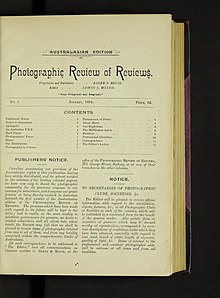Australasian Photo-Review

The Australasian Photo-Review was an English language magazine, published for photographers by Baker & Rouse and later Kodak (Australasia), and published in Sydney, Australia 1894–1956.[1]
History[]
The magazine was first published in 1894 as the Australian edition of the British Photographic Review of Reviews, after the photographic supply company Baker & Rouse purchased the Australasian publishing rights.[2] At this early stage of its publication, the magazine was issued as a short ten to fifteen page supplement to the British edition.[3] In 1895 the magazine's name was changed to Australalasian Photographic Review, and in 1903, the title was shortened to Australalasian Photo-Review.[4]
The first editor-in-chief of the magazine was Edwin J. Welch F.R.G.S., F.R.C.I., who declared in the first issue that Australian photographic works would be reviewed with 'bluntness, perhaps, but no namby pamby'.[4][2] Walter Burke F.R.P.S. was Editor. In 1922 Walter's son Eric Keast Burke became associate editor and, in 1943 editor, a position he held until the Review ceased publication in 1956.[5]
Content[]
The Review is notable for promoting the work of Australian photographers or 'camerists', as they were referred to in early editions, and for its inclusion of high-grade photographic prints.[2][6]
At a time when the nation's history of photography was scant and under-appreciated, Keast Burke's series of historical articles included articles on pioneering Australian photographers John William Lindt and Charles Kerry and on his 1953 discovery, in a shed in Chatswood, New South Wales, B. O. Holtermann’s collection of wet-plate negatives; all gold-fields photographs by Charles Bayliss and Beaufoy Merlin to whom he devoted several issues of AP-R, and later published Gold and silver : an album of Hill End and Gulgong photographs from the Holtermann Collection in 1973. [7] His father Walter had also been historically minded and both Keast’s son Quentin, and wife Iris, assisted in research and article writing for the AP-R. Jack Cato consulted extensively with Keast in writing his 1955 history The Story of the Camera in Australia.[8] Having formally retired in 1960, from 1961 to 1969 Burke was the first editor and then art director of Australian Popular Photography (later named Australian Photography)[9]
Digitisation[]
The magazine has been digitised by the National Library of Australia.
References[]
- ^ "Australasian Photo-review Magazine or periodical". Dictionary of Sydney. Retrieved 19 July 2018.
- ^ Jump up to: a b c Welch, Edwin J (January 1894). "Publisher's Notice". Photographic Review of Reviews (1): 3–4.
- ^ Welch, Edwin (January 1894). "An Australian P.P.R." Photographic Review of Reviews (1): 4. Retrieved 19 July 2018.
- ^ Jump up to: a b "Caption Title". Australian Photo-Review. X (1): 1. January 1903.
- ^ Australian Dictionary of Biography.. Retrieved 6 June 2014.
- ^ Matthew, Jill Julius. "Australasian Photo-Review periodical". Austlit. Retrieved 20 July 2018.
- ^ Holtermann, Bernhardt Otto; Burke, Keast, (editor.); Holtermann Collection (1973), Gold and silver : an album of Hill End and Gulgong photographs from the Holtermann Collection, Heinemann, ISBN 978-0-85561-005-0CS1 maint: multiple names: authors list (link) CS1 maint: extra text: authors list (link)
- ^ Cato, Jack (1955), The story of the camera in Australia (1st ed.), Georgian House, ISBN 9780959683905
- ^ Australian Photographic Society; Australian Photographic Federation (1961), Australian popular photography, Photo Publishing Co
External links[]
- Magazines published in Australia
- English-language magazines
- Magazines established in 1894
- Photography in Australia
- History of photography
- Australia stubs
- Magazines disestablished in 1956